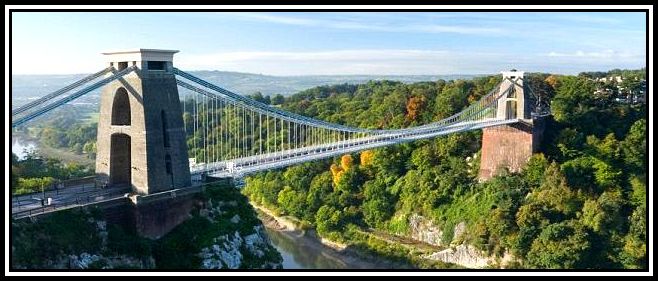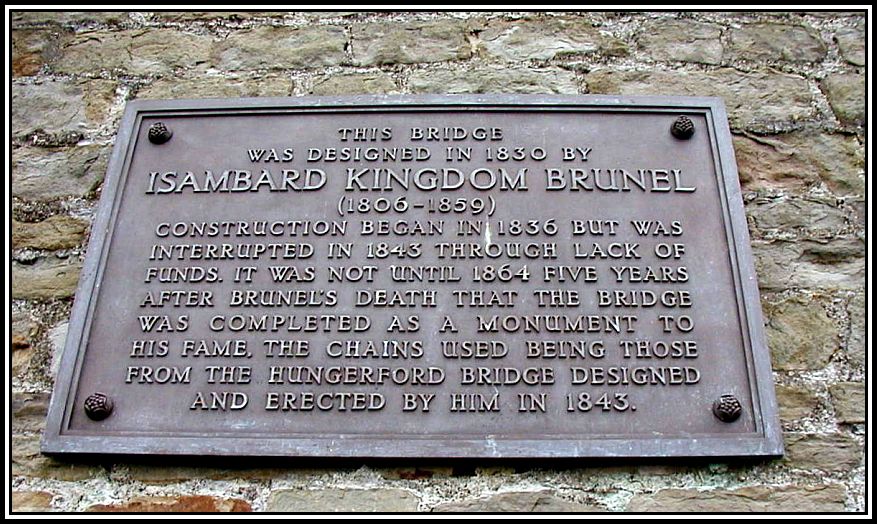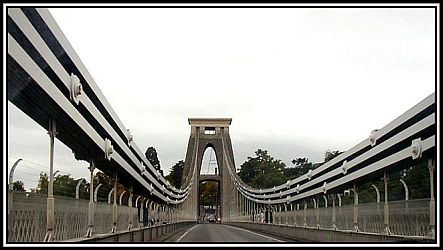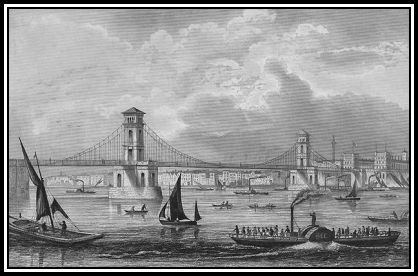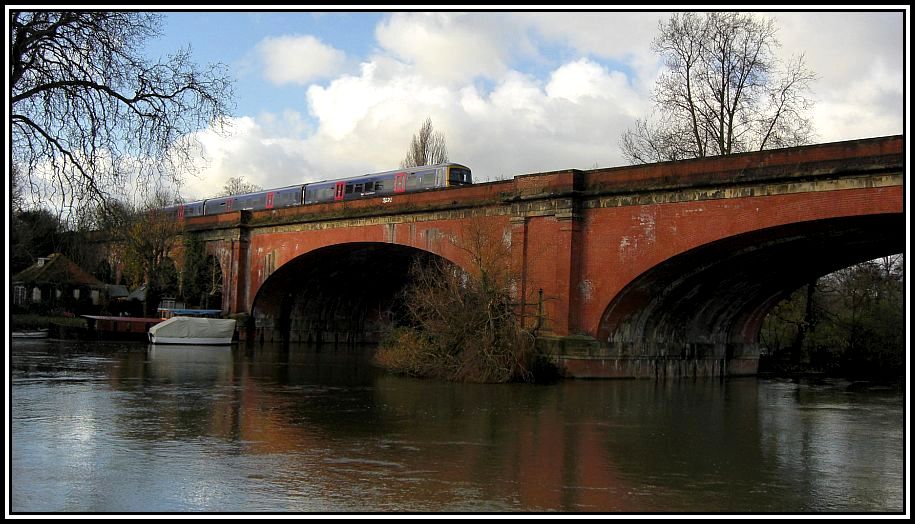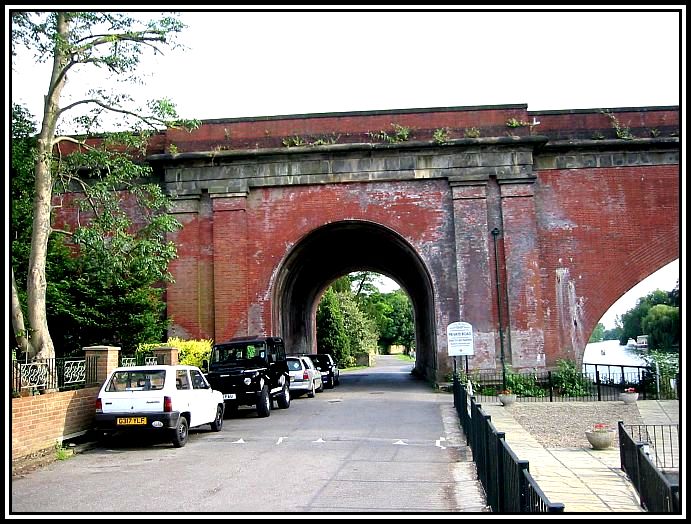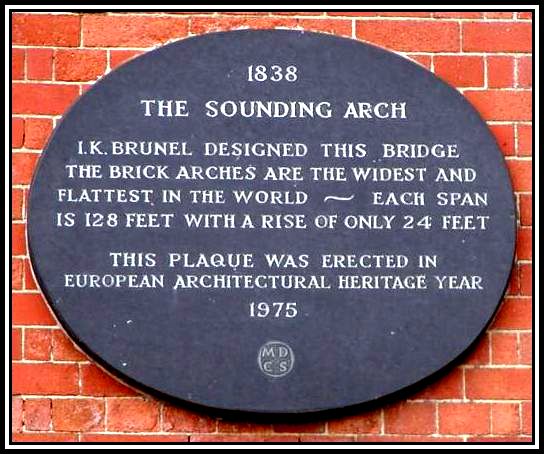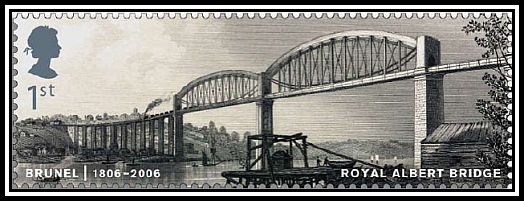ISAMBARD KINGDOM BRUNEL
Isambard Kingdom Brunel (1806-1859) was a Mechanical and Civil Engineer of great note and built the Great Western Railway, a number of steamships, dockyards, bridges, viaducts and tunnels. Brunel was, to say the least, innovative, and had a marked impact on transport and modern engineering.
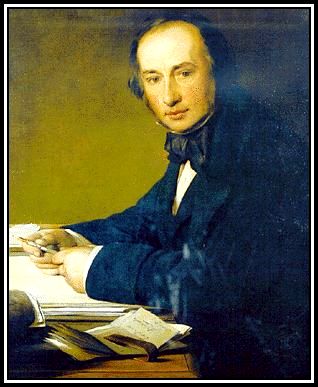
Isambard Kingdom Brunel at his desk
-oOo-
PAGE FOUR: THE BRUNEL BRIDGES
As a result of Brunel’s work with the Great Western Railway, he built a number of bridges, train, railway stations and tunnels. As part of his work building steamships, he also was involved in the construction of dockyards.
-oOo-
CLIFTON SUSPENSION BRIDGE
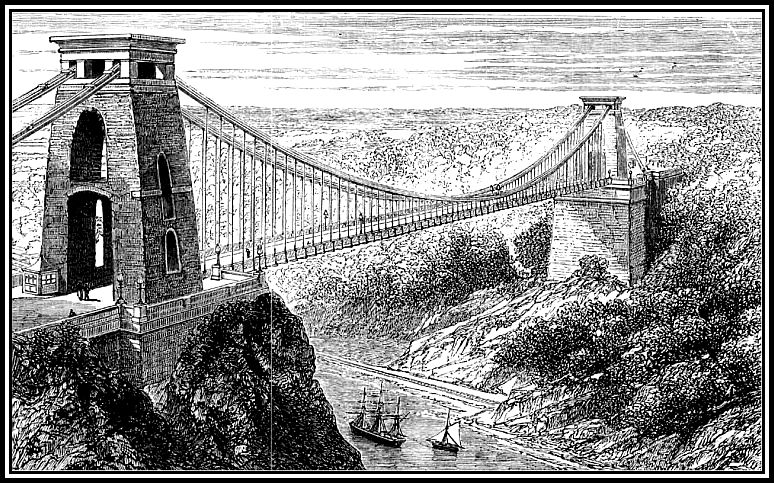 Drawing of The Clifton Suspension Bridge, 1878
Drawing of The Clifton Suspension Bridge, 1878
Brunel is perhaps best remembered for his designs for the Clifton Suspension Bridge in Bristol. A competition was held in 1829 to find the most suitable design for bridge across the River Avon-Avon Gorge with Thomas Telford (1757-1839) as judge. He rejected all designs and then put forward his own, which was not well received. A second competition was held in 1830 and was won by Brunel. He was 24 years of age at the time and this was his first commission. The bridge was designed for pedestrians and horse-drawn traffic, but was found later to support automobile traffic. Seemingly the Bridge is able to support ~500 tons of weight with only a slight sag at its centre.
The Bridge was built based on his designs, but with significant changes. Spanning over 702 feet (214 metres), and nominally 249 feet (76 meters) above the River Avon. In the early stages of construction, the workers crossed the river in a basket, which ran beneath an iron bar that was ~1,000 feet long (307 metres). At one point, the basket became stuck. Apparently Brunel climbed up and freed the rollers and the basket continued on its route.
Work began on the building of the Clifton Suspension Bridge in 1831, but was suspended due to the Queen Square Riots, which drove away investors.
-oOo-
The riots were the result of the rejection by the House of Lords of the Second Reform Bill. Passage of this Bill would have seen an end to some of the Rotten Boroughs. A Rotten Borough was a Parliamentary Constituency with few constituents and often controlled by wealthy landowners. Passage of the Bill would have allowed an increase in the number of Parlimentary Seats in the House of Commons that represent the fast growing industrial towns.
During the riots, between 500 and 600 young men besieged the Bristol Mansion House in Queen Square and demolished a number of other buildings including the Jail. With stoppage of work on the Clifton Suspension Bridge, Brunel was sworn in as a Special Constable.
-oOo-
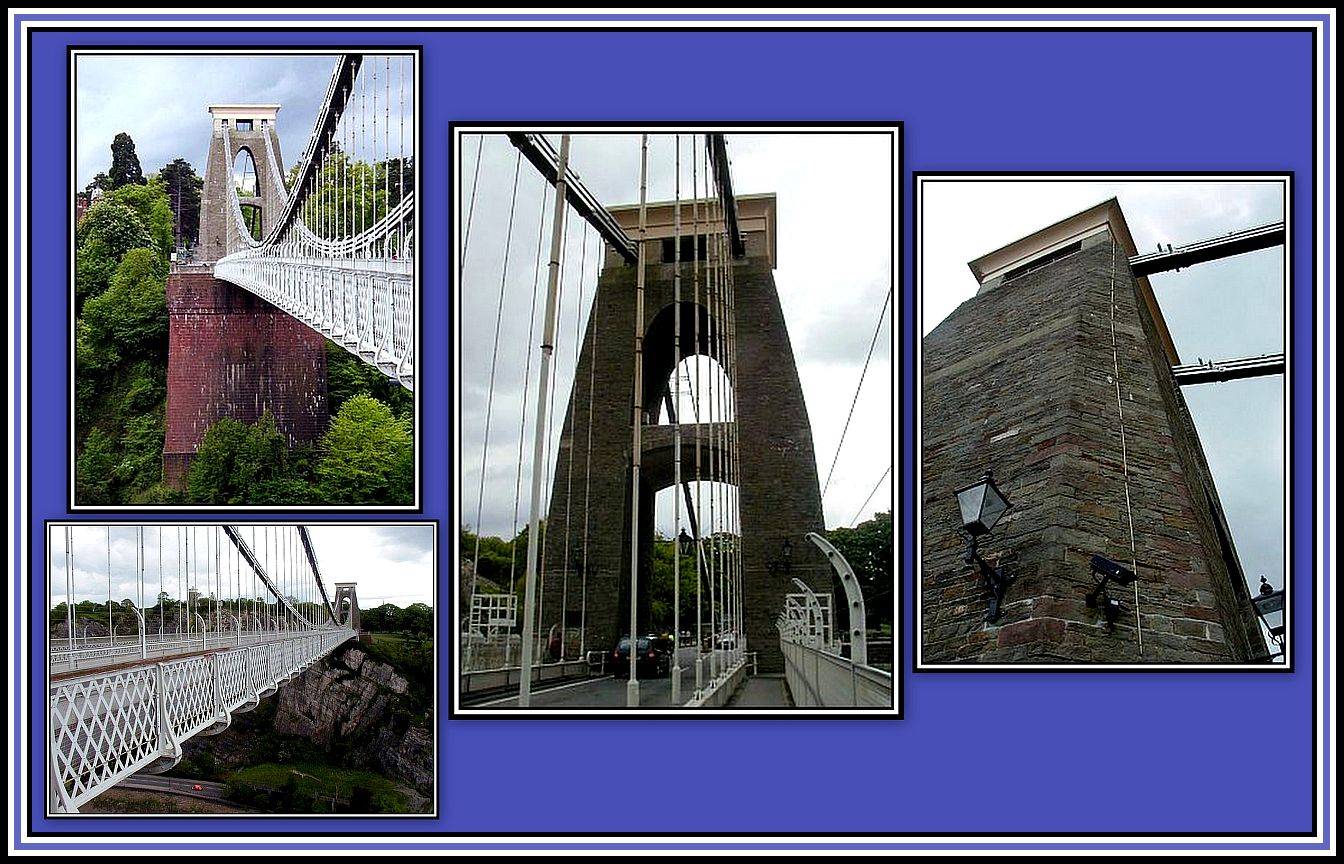 The Clifton Suspension Bridge; these photographs were provided by Paul Bland
The Clifton Suspension Bridge; these photographs were provided by Paul Bland
Brunel died in 1859 and did not live to see the Bridge completed. However, his colleagues and admirers at the Institution of Civil Engineers believed that the Bridge would be a fitting memorial to him and started to raise new funds and to amend the design. Work recommenced in 1862 and was completed in 1864. The Bridge had the longest span of any bridge in the world at the time of construction.
This photograph was provided by Paul Bland
At the time of building, Brunel’s Hungerford Bridge across the River Thames was in the process of being demolished. The suspension chains from the Bridge were removed and used to complete the Clifton Suspension Bridge. Seemingly the Abutments of the Bridge house a number of tunnels and vaults whose constructions reduced the cost of building, but without reducing its strength.
Driving across the Bridge; photograph provided by Paul Bland
-oOo-
HUNGERFORD BRIDGE
The first Hungerford Bridge, a suspension footbridge across the Thames near Charing Cross Station, was built by Brunel. The first stone was lain in 1841 and opened in 1845. The span of the central opening was 6761⁄2 feet and was greater than that of any suspension-bridge in Britain at the time and second only to the suspension-bridge at Fribourg, Switzerland whose span is almost 900 feet.
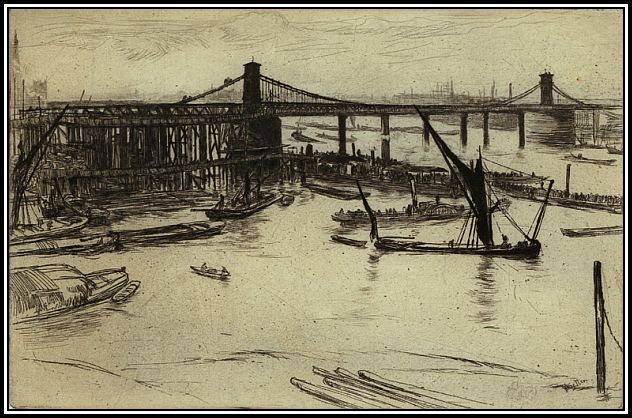 Hungerford Bridge by James Abbott McNeill Whistler (1834-1903)
Hungerford Bridge by James Abbott McNeill Whistler (1834-1903)
The Bridge was named after Hungerford Market, which was on the North Bank of the Thames. In 1859 the original Bridge was bought and replaced by a new railway bridge so as to allow the South Eastern Railway into enter the newly opened Charing Cross Railway Station
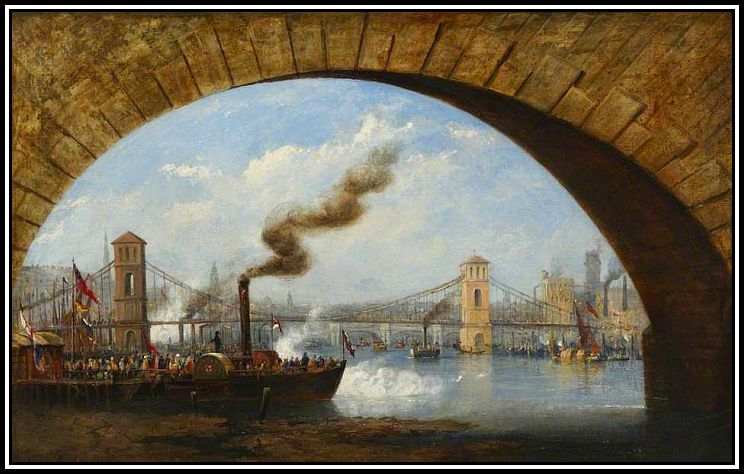 Hungerford Bridge by James Holland (1799-1870)
Hungerford Bridge by James Holland (1799-1870)
-oOo-
MAIDENHEAD BRIDGE
Brunel also built the Maidenhead Railway Bridge, also known as the Maidenhead Viaduct and The Sounding Arch. The Bridge carries the main line of the Great Western Railway over the River Thames between Maidenhead, Berkshire and Taplow, Buckinghamshire and was completed in 1838, but did not come into service until July 1839.
The Bridge has two brick arches, which at the time of building was the widest and flattest in the world. Each span is 128 feet (39 metres) with a rise of only 24 feet (7 metres). The flatness of the arches was necessary to avoid putting a hump in the bridge, which Brunel disliked, preferring flat, gentle gradients.
The Thames Towpath passes under the right-hand arch (facing upstream), which is also known as The Sounding Arch, because of its remarkable echo.
When the Bridge opened, it carried two 7 feet (2,134 mm) wide Brunel Gauge Railway Tracks. In 1861, mixed track (i.e. Brunel and Standard Gauge Tracks) was added between London and Bristol. Between 1890 and 1892, the Bridge was widened on each side to carry four Standard Gauge Tracks, which would soon totally replace the Brunel Gauge Tracks. Widening of the Bridge from 30 feet (9.1 metres) to 57 feet 3 inches (17.5 metres) was conducted under the supervision of Sir John Fowler (1817-1898).
-oOo-
The Bridge is featured in Rain, Steam and Speed – The Great Western Railway, painted by J.M.W. Turner (1775-1851) in 1844.
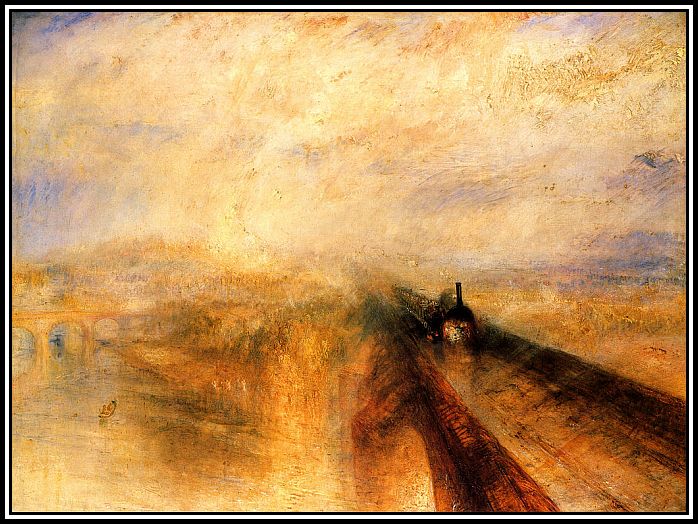 Rain, Steam and Speed – The Great Western Railway
Rain, Steam and Speed – The Great Western Railway
-oOo-
ROYAL ALBERT BRIDGE
In 1845, the Cornwall Railway Company applied for an Act of Parliament that would allow the Company to build a railway line that would link Plymouth in Devon to Falmouth in Cornwall via a coastal route and which would pass through the naval town of Devonport and the industrial area of St Austell. This proposal was supported by the Great Western Railway, as it wanted the line to join up with the South Devon Railway at Devonport and others routes that it operated. However, Parliament rejected the proposal mainly because of William Moorsom‘s plan to carry trains across the Hamoaze on the Devonport-to-Torpoint Ferry. The Hamoaze is an estuarine stretch of the tidal River Tamar, between its confluence with the River Lynher and Plymouth Sound.
Following the rejection of The Bill, Isambard Kingdom Brunel was consulted and he agreed to take over as the engineer of the project and proposed that the railway line should cross the river further upstream via a bridge to be built at Saltash. Parliament agreed to the change of plan with the result that The Act was passed on the 3rd August, 1846.
-oOo-
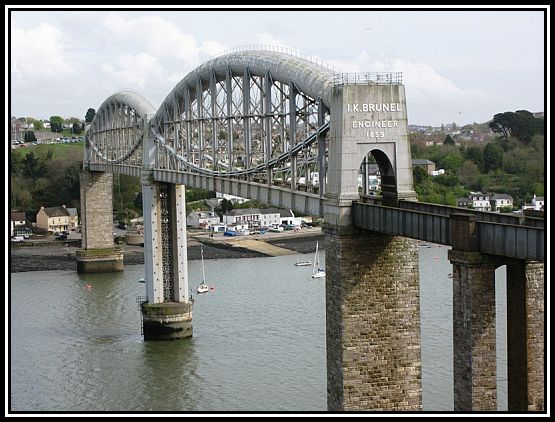 Royal Albert Bridge over the River Tamar
Royal Albert Bridge over the River Tamar
The Royal Albert Bridge at Saltash was Brunel’s final bridge. The authorities demanded that it be a bridge with a minimum headway of 100 feet (30.5 metres) above mean high spring tide.
The River Tamar is 1,100 feet wide (335.28 metres) at the point where the Bridge was to be built. Brunel planned originally to build a bridge with one 850 feet span, but the final accepted design was one with a double-span of 455 feet (138.7 metres) together with long approach viaducts.
The Company planned a two-way track across the Bridge, but the Cornwall Railway Company lacked sufficient funds to achieve this aim. Despite settling for a sing track the Company went bankrupt. Brunel decided to take on the contract himself and on the 4th July, 1853, the foundation for the first piers on the Cornish side of the River was lain down.
On the 1st September, 1857, the first Truss of the Bridge was floated into the centre of the River Tamar and then raised at a rate of 6 feet per WEEK by the use of Hydraulic Jacks. On the 1st July, 1858, the Truss had been raised to its final height of 100 feet above the River.
The second Truss was floated into the centre of River on the 10th July, 1858 and work began to ease it into place.
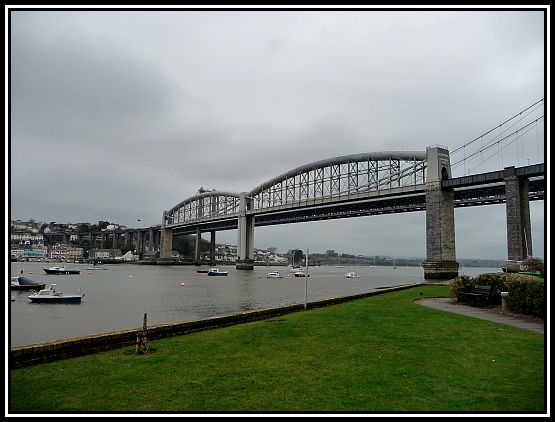 Royal Albert Bridege; this photograph appears with permission of the photographer, Ms Annie Barnes
Royal Albert Bridege; this photograph appears with permission of the photographer, Ms Annie Barnes
A test train went across the Bridge on the 11th April, 1859 and, on the 2nd May, 1859, Prince Albert officially opened the Bridge. Illness stopped Brunel from attending the Opening Ceremony and had to be represented by his Chief Assistant, Robert Brereton (1818-1894). However, Brunel did cross it two days later in an open wagon. The Bridge entered public services on the 4th May, 1859.
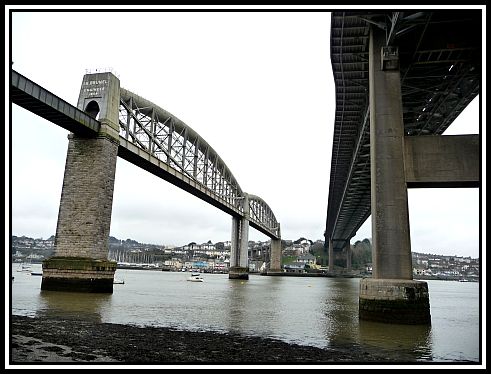 Royal Albert Bridege from beneath the Tamar Bridge; this photograph appears with permission of the photographer, Ms Annie Barnes
Royal Albert Bridege from beneath the Tamar Bridge; this photograph appears with permission of the photographer, Ms Annie Barnes
With Brunel’s death on the 15th September, 1859, the Company decided to make the Bridge a memorial to him with the adding of the following words in metal letters at the both ends of the Bridge:
I.K. BRUNEL, ENGINEER, 1859.
Between the 21st and 22nd May, 1892, the Track Gauge over the Bridge was converted from Brunel (7 feet 1⁄4 inch; 2,140 mm) to Standard Gauge (4 feet 8 1⁄2 inches; 1,435 mm), as part of the conversion process being undertaken by the Great Western Railway.
-oOo-
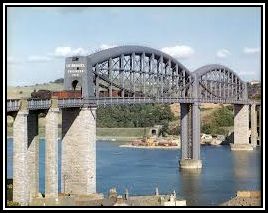 In 1952, the Royal Albert Bridge was Grade 1 listed by English Heritage
In 1952, the Royal Albert Bridge was Grade 1 listed by English Heritage
-oOo-
In 1961, the Tamar Bridge was opened, which runs adjacent to the Royal Albert Bridge. The bridge was the longest suspension bridge in the U.K. and in 2001 became the world’s first suspension bridge to be widened using Cantilevers.
As attractive as the Tamar Bridge is, I cannot but feel that it would have been better for those of us who are admirers of Mr. Brunel had it been built a little further up- or downstream in order for both sides of his Bridge to be equally admired and enjoyed. I wonder who makes these decisions.
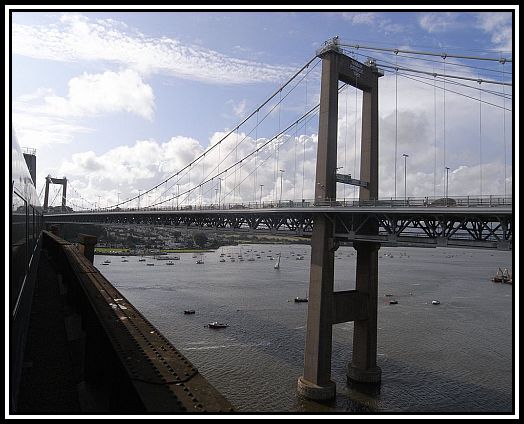 Tamar Bridge from train by David McCormick; licensed under CC BY-SA 3.0 via Wikimedia Commons
Tamar Bridge from train by David McCormick; licensed under CC BY-SA 3.0 via Wikimedia Commons
-oOo-
Click here
to watch the video, Great Britons: Isambard Kingdom Brunel, hosted by Jeremy Clarkson
——oooOOOooo——
Click on each of the following links to read more of
Mr. Brunel’s remarkable achievements
HOME PAGE
-oOo-
PAGE ONE: THE EARLY YEARS
-oOo-
PAGE TWO: THE GREAT WEST RAILWAY
-oOo-
PAGE THREE: THE BRUNEL STEAMSHIPS
-oOo-
PAGE FIVE: THE BRUNEL MEMORIAL
——oooOOOooo——
Readers can TWEET their LIKES & DISLIKES to me at
or
make comments on the Website’s FACEBOOK PAGE
or
consider leaving a Comment below.
——oooOOOooo——
ACKNOWLEDGEMENTS
I would like to thank Mr. Paul Bland for allowing his photographs to appear here.
I would also like to thank Ms Annie Barnes for her help and consideration and for allowing some of her photographs to appear here.
Finally, I would like to thank Mr. Dominic Rowe of the SS Great Britain Trust for his help and consideration and for allowing some of the Trust’s photographs (credited to Mr. David Noton) to appear here.
——oooOOOooo——
Click here to GO to A SERIES OF WALKS ALONG THE EMBANKMENT Home Page
——oooOOOooo——
Click here to go to PART FOUR: VICTORIA EMBANKMENT GARDENS
——oooOOOooo——
Click here to RETURN to the TABLE OF CONTENTS
——oooOOOooo——

